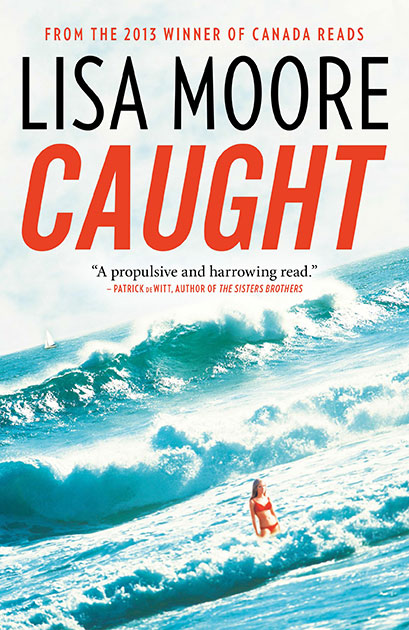“Everything will happen from here, he thought. This time they would do it right. He could feel luck like an animal presence, feral and watchful. He would have to coax it into the open. Grab it by the throat.” This is what Slaney thinks as he crouches on the side of a moonlit highway in Nova Scotia. He has just escaped from prison and is already planning his next operation.
The premise of Lisa Moore’s third novel, Caught, is a simple one: a fugitive trying to pull off a crazy drug deal. The beauty of the novel comes from watching Moore unravel it all.
David Slaney, jailed for his wild attempt to smuggle a massive amount of pot from Colombia to Newfoundland, has just escaped from prison and wants to finish the operation he started four years earlier with his best friend and partner-in-crime, Hearn. There is a grand, elaborate, and risky scheme planned, one that will take Slaney all across Canada, through Mexico, and down into Colombia. Meanwhile, there is Patterson, plain and somewhat of a pushover, who is assigned by the authorities to track down Slaney and bring his grandiose plan to a halt. Moore’s novel tosses between these two perspectives. As the characters in the novel question who they can trust, the reader is forced into the same predicament. Which character is the most reliable? Which character can be trusted to succeed?
Although, like a typical thriller, the story is driven by action and adrenaline, Moore’s carefully crafted characters are the real thrill of the novel. The main roles – Slaney and Patterson – are both solidly constructed. Moore blurs the boundary between ‘good guy’ and ‘bad guy’ with her portrayals of Slaney and Patterson; both are simultaneously endearing and repellent, and neither fails to surprise.
However, it is the countless side characters – the ones that drift into the narrative for a few pages, or maybe even just a few paragraphs – who are the most captivating. There are the two strippers that accompany Slaney for a meal of burnt hot dogs on the fire escape. Then, there is the homely motel receptionist whose “black crocheted shawl was smeared over her with static electricity,” and the sassy French-Canadian saleswoman who imparts subtle lessons in feminism to her customers at the toy store. There is the sailor on the verge of a mental breakdown; the trucker who breeds dogs in his spare time; the mother of a son who died too young. No matter how briefly the character appears in the story, Moore never resorts to even the slightest ounce of stereotype. These briefly encountered characters may play bit parts, but the depth they bring to the novel is astounding.
The locales Slaney finds himself in are just as enthralling. Moore takes us on a tour of Canada, though one radically different from anything found in a travel guide. The famous lupin fields of Nova Scotia become a place for Slaney to hide from the cops; the only side of a sophisticated Montreal we see is a grimy anglo pub; and the dry, golden prairies are rainy and viewed mostly from the inside of a chicken truck. Moore’s cross-country tour provides the reader with a sharp new perspective on Canada’s glorious landscape. Our home and native land: through the eyes of a fugitive.
There is so much more to praise Moore for. The novel is rich with her subtle injections of humour, her careful pacing, and her clear yet coarse dialogue that leaves just enough unsaid. Of course, it also lives up to the ultimate test of a thriller – there is no doubt that this is a page-turner.
There is a character in the novel, a vicarious reader of mysteries, who tosses every book she finishes off the edge of the boat and into the water. Read Caught vicariously, but don’t throw this one to the fishes.
